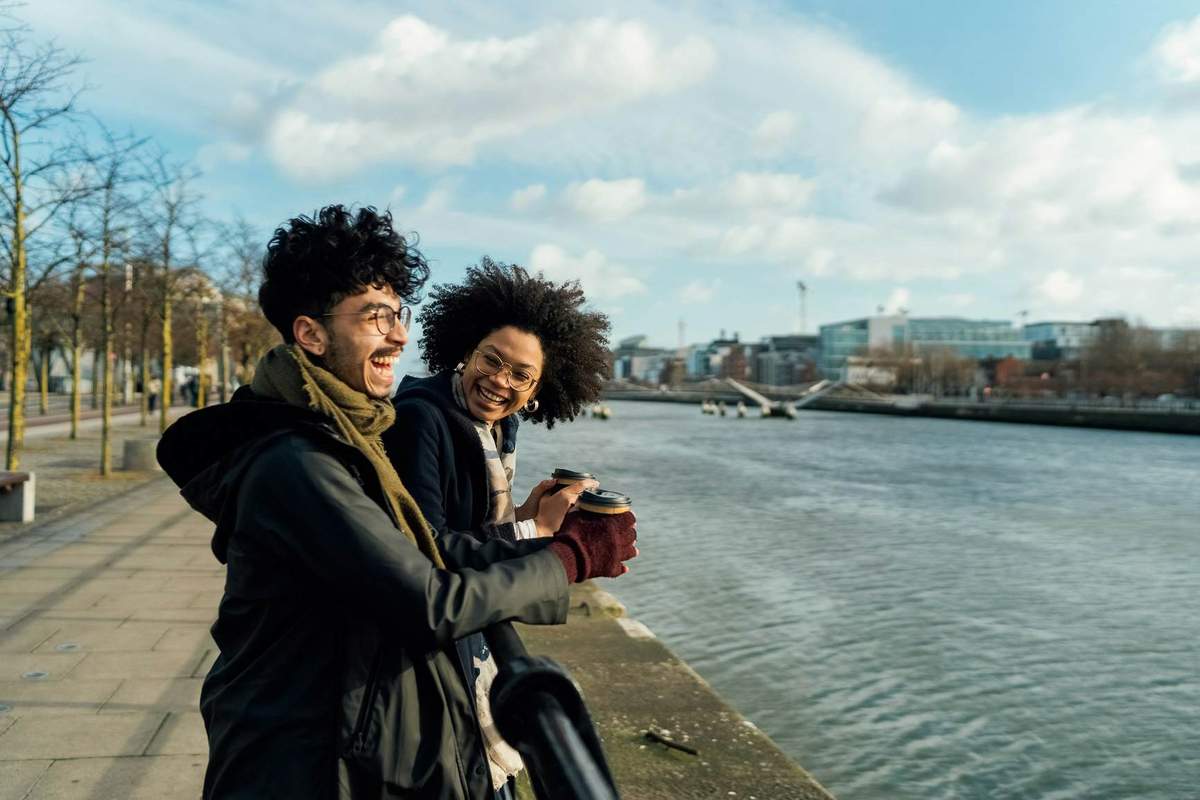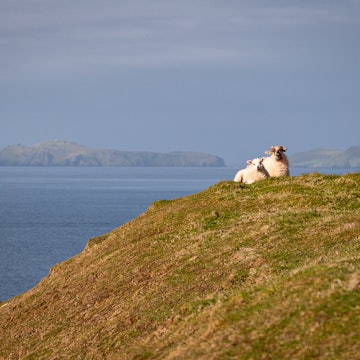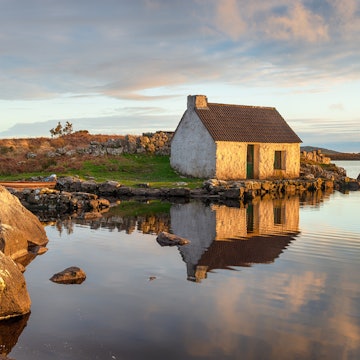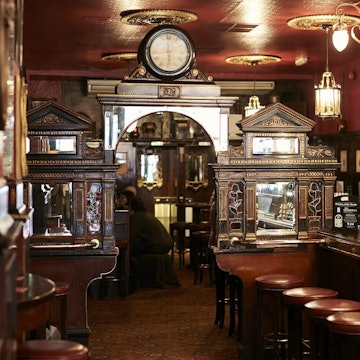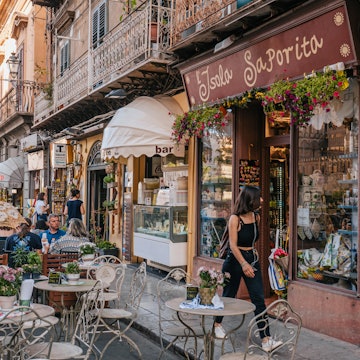

Tourists walking along the cobbled streets in Temple Bar, Dublin. Edwin Remsberg/Getty Images
Dublin may not take up much space on the map, but don't let that fool you – this gem of a capital has no "off" switch and is brimming with history, culture and a whole lot of personality that is on display twelve months of the year. There’s an old Irish adage that says, "If you don’t like the season, just wait fifteen minutes." Dublin is a city for all seasons and those seasons will often present themselves in the one day.
Most visitors arrive during the warmer summer months, when Dublin’s events calendar is at its fullest and there’s hardly a moment to spare between festivals, live music and street parties. When the skies turn gray and the temperatures start to dip, that's a Dubliner’s cue to dive into the city’s rich cultural scene with its array of museums, events and theaters – and although there's a thinner menu of outdoor events, come equipped for the colder weather. This is everything you need to know in order to choose the best time to visit Dublin.

June to August is the best time for good weather and long days
Weather in Dublin during summer: It's the warmest time of the year and the sunset happens late in the evening, giving you endless hours of daylight to explore and have fun. Temperatures hover around 18-25°C, but remember this is Ireland – clouds and rain showers are never ruled out.
With its warmer days and plentiful events, many consider June through August the best time to visit Dublin. Summer is peak season for visitors looking to take advantage of the good weather and therefore it's also when accommodation is toughest to find and room rates are at their highest. If you are visiting during these months, it is strongly advised to book well in advance to avoid disappointment or paying through the nose for a room.
There is plenty to do throughout the Dublin summer, and locals eagerly fill out their festival calendars. There’s big music gatherings like Forbidden Fruit and Longitude; the annual Pride celebrations take up a week in June; and they come after the most Dublin of Dublin events – Bloomsday, when the most dedicated Joyceans go all Edwardian for a day on June 16. Another uniquely Dublin event is the Liffey Swim, which sees 500 people swim 2.2km along the Liffey – you can join them if you want (or just go to the National Gallery to see Jack B Yeats’ famous painting of it). Food-lovers visiting in mid-August head to Herbert Park for The Big Grill, Europe’s largest barbecue and food festival where Irish and international chefs celebrate the art of cooking over live fire.
Meanwhile, the international equestrian set trots down to the Royal Dublin Society (RDS) for the social highlight of the year, the Dublin Horse Show. The show is a long-established institution in the city: one-part genteel garden party, one- part agricultural show, the highlight of the five-day long festival is the Aga Khan Trophy, an international-class competition packed with often heart-stopping excitement in which eight nations participate.
In addition to some of the biggest events of the year, summer is the perfect time to see Dublin on foot. Wander the grounds of St Stephen’s Green or browse the shops of Grafton Street. Take some time to stop into a local pub for a pint or two and be entertained by street buskers along the way. And what’s a summer holiday without a day at the beach? A quick train ride on the DART will take you to Dublin’s most beautiful shores, from Killiney Beach to Balscadden Bay. Amble along the promenade at Sandymount Strand (the closest beach to the city center), take in stunning seaside views along the Howth cliff walk or go for a dip at Forty Foot Pool, Portmarnock or Seapoint.

March to May is the best time for festival fun
Weather in Dublin during spring: The winter chill eases off and the days start to lengthen as spring warms up. Pack layers as there will be plenty of rain showers and temperatures will hover between 11 and 16°C.
Dublin unofficially leaves winter behind around the middle of March when the St Patrick’s Day Festival takes over for the city a few days. Half a million people turn out to see the parade on March 17 and enjoy the festivities, which can leave the city looking the worse for wear when the music ends and the beer stops flowing. Outside of St Paddy’s Day and Easter, though, accommodation rates can be pretty enticing and the city hasn’t yet welcomed the summer crowds.
The biggest event in April is the Grand National, the showcase of the national hunt season that takes place at Fairyhouse in County Meath, 25km northwest of the city center, on Easter Monday. Despite the name, the only thing they hunt is the winner’s garland. Meanwhile, the Five Lamps Festival celebrates the creativity of the north inner city over nine days. In May, Dublin warms up for the summer with the International Dublin Gay Theatre Festival and the International Literature Festival Dublin.
Spring is also a lovely time to explore the blossoming unfolding in Dublin’s parks and gardens. From the Victorian greenhouses filled with rare and tropical flora at the National Botanic Garden to the Roman-style architecture of St Anne’s Park, each of the city’s green spaces offers a unique character and charm. Browse local goods at the Red Stables Food Market at St Anne’s on Saturdays or stroll through Herbert Park on Sundays to peruse artisan delicacies and crafts.

September and October are best for crowd-free sunny days
Weather in Dublin during fall: Beautiful colors sweep through the city's parks and gardens when fall arrives. The temperature dips but tends to hover around 15-18°C – perfectly pleasant for exploring on foot. The days begin to grow shorter but that's all the more reason to duck into a cosy pub when the sun goes down.
The high season officially ends in September: kids are back at school, crowds are thinning out and accommodation rates start to come down. It’s an easier time to find a room at a decent rate, especially if you book in advance.
September and October can surprise you with some excellent weather. Although average highs hover around 16ºC, it’s not at all uncommon for the city to enjoy a late burst of summer. Which means you can combine some indoor pursuits with some outdoor excursions. Enjoy a day trip to Glendalough (blissfully free of big crowds now that the kids are all back in school), followed by a performance at one of Dublin’s theater festivals – the Fringe in September or the Dublin Theatre Festival in late September through to mid-October.
Chilly evenings make fall the perfect time to explore Dublin’s creative spirit, from taking in a performance at the iconic Abbey Theatre to discovering the city’s past at its lesser-known museums. On the second to last Friday of September, the city celebrates Culture Night with special events and workshops to highlight Ireland’s rich and diverse heritage in venues across the city. In October, the Bram Stoker Festival brings gothic thrills to Dublin in honor of the legendary author.

November to February is best for cozy pubs and budget breaks
Weather in Dublin during winter: There's no point in sugarcoating it – winter in Dublin is cold, damp and a little dreary. However, this is when the city's cozy pubs come into their own and everyone gathers together to chase away the winter gloom.
There are plenty of options throughout the city – 800 of them, in fact – but you won’t go too wrong in the likes of Kehoe’s just off Grafton Street or The Long Hall on South Great George’s Street, beloved by Dubliners and Bruce Springsteen, who pops in every time he visits. Other great indoor pursuits include going to see some live music – Whelan’s is a popular venue to check out acts on the rise (or on their way down).
Dublin is justifiably renowned as a UNESCO City of Literature, and in November the Dublin Book Festival is held over five days in over 80 venues throughout the city, featuring author interviews, talks and themed guided walks. Host venues include the National Library of Ireland, the National Botanic Gardens, the Royal Dublin Society plus a host of bookshops and arts centers throughout Dublin.
From November through to the end of January, Winter in Dublin combines gigs, events and a massive New Year’s Eve festival spread over multiple venues across the city center. Search for gifts at the Dublin Castle Christmas Market or head to the Dun Laoghaire Christmas Festival for a spin on Ireland’s largest ice rink.
For a traditional Irish Christmas, enjoy carol services at St Patrick’s Cathedral or visit the Moving Crib, a long-standing holiday display featuring detailed set pieces and animatronics depicting the nativity. If you’re willing to brave the crowds, the annual Christmas Eve busk on Grafton Street is a free outdoor concert and sing-a-long that raises money for charity.

Once the festive season is over, locals lay low, and January and February will be much quieter. This is a great time to explore museums or make like a Dubliner and visit one of the city’s independent cinemas such as the Light House Cinema in Smithfield or the Irish Film Institute in Temple Bar.
In 1900, the National Gallery was given 31 watercolors by JMW Turner under one condition: in order to protect their delicate pigment, they can only be displayed in January, when the winter light is at its weakest. Although lighting systems now exist that can simulate January’s weaker light, the gallery has maintained its promise and you can only see these stunning works for one month a year.
February sees the start of the Six Nations rugby championship, and Ireland have recently been the tournament’s best side. Even if you can’t nab a ticket for a home game, there’s still a great atmosphere in town when Ireland are playing away – so much so that fans of rival teams will often come to Dublin for the weekend. February is also when the Dublin International Film Festival is on, which highlights the best of local and (some) international film.






